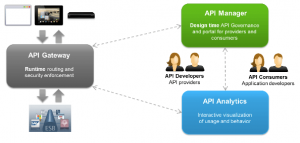The increasing demand from Internet Business Models, Internet Streaming Boom and Cloud Adoption is uncovering the need for further investment in the API Management domain. In this blog, I describe the history, the future and the reasons for investing in API Management.
1. APIs and API Management are not a new phenomenon
The modern Web APIs movement was born in 2000 with the publication of Roy Fielding dissertation Architectural Styles and the Design of Network-based Software Architectures. In chapter 5, Fielding introduced the Representational State Transfer (REST) architectural style for distributed hypermedia systems and ever since APIs have sustained the evolution of Digital Commerce, Social Media, Cloud Computing and the Mobile Channel.
By 2006, Mashery launched the first solution for API Management. The platform offered documentation support and access control for companies wishing to expose APIs. The initial version of the platform was poor in features, but it was an important mark, establishing a new domain in the application integration world.
2 – API Management is the process of publishing, promoting and governing APIs, in a secure and scalable environment
Three main requirements drive API Management solutions:
- API Security – Organizations must ensure that published APIs do not pose a security liability. Uncontrolled access to sensitive information from data, content and services cannot be allowed, and the underlying systems must be protected with authentication, rate limiting and quotas.
- API Governance – Central governance of the APIs, reducing a lot of the technical debt and double-work. API discoverability, API reusability, API lifecycle, rich API documentation, API monetization. Portal capability, connecting API Developers to API Consumers.
- API Analytics – Centralized gathering and analysis of API Analytics, providing real time dashboards. Understand API usage and performance through interactive reporting, for both API Developers and API Consumers.
Mapping to technology, the typical implementation of API Management is realized through the integration of three specific components/modules:
- API Gateway – Runtime component, responsible for routing and security enforcement
- API Manager – Design time API Governance and portal for providers and consumers
- API Analytics – Interactive visualization of usage and behavior

3 – Business demands for increased IT responsiveness requires further investment into API Management
Multiple drivers are pushing consumer grade API Management to become a must-have core IT Service of a Digital Enterprise – API Management is becoming a basic primitive offering of the IT Portfolio.
Mobile devices have become the first choice of a customer to facilitate engagement. Providing outstanding mobile customer interaction experience is now more than ever dependent on rich and complex APIs.
The premise of success for Digital Economy is ability to quickly establish Dynamic Digital Partnerships, enabling the creation of new-age services. APIs are the key foundation for realization of those complex multi-partner ecosystem.
The adoption of External Cloud and SaaS solutions has led to increased Security threats. APIs are available all the time, from everywhere, and accessible from multiple platforms – in transit Customer data needs to be protected.
Internet servicing is growing at a massive rate, putting strain on existing infrastructure and business models. Also, the number of API calls will grow exponentially in the years to come, mainly fueled by the innovation around IoT.
“Providing outstanding mobile customer interaction experience is now more than ever dependent on rich and complex APIs.”

